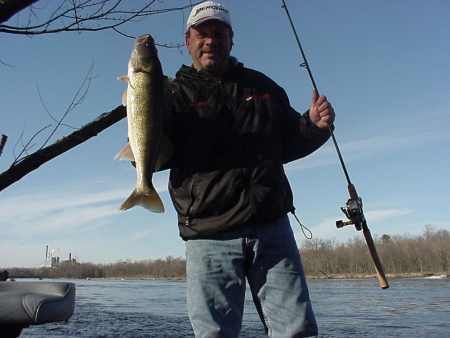| Every open-water walleye season begins with the promise
of big fish and lots of them. That's the way the season ends
on most major bodies of water, too.
More than any other angling pursuit, walleye fishing comes
full circle. What worked in April usually works in November
and many of the locations will be similar, if not the same.
After some of the head-scratching frustration that can accompany
the annual transition period in September when water temperatures
are changing, forage is plentiful and fish are scattered and
on the move, it's almost a relief to get deeper into the fall
season when walleyes actually become concentrated and somewhat
predictable again.
 |
One of the things I most enjoy about these times of
year is jigging for my walleyes. It's a simple but deadly
technique in which the angler is fully invested with a
rod in hand (or one in each hand). You supply the action
and the reaction, and there's nothing like the solid "tunk"
of a good walleye bite transmitted back to the angler
through Yo-Zuri fluorocarbon line and a quality graphite
spinning rod. |
In fact, there are many November outings when I leave everything
in the garage except for a box of jigs, a selection of Lindy
Munchies grubs and ringworms, a handful of spoons and a couple
of spinning outfits.
Most of my November walleye and sauger fishing takes place
on river systems or in areas where rivers meet up with big
lakes and reservoirs.
Primarily, I'm looking for current breaks and eddies positioned
over hard-bottomed areas with access to deep water, but not
too far from the shallow flats walleyes roam when they tie
on the feedbag during low-light periods.
I never set up and begin fishing an unknown area until I've
first done a recon with my Lowrance 111 HD sonar/GPS unit.
First, it details the breakline. Second, it lets me know if
the substrate is hard or soft. And third, it shows me if there
are fish present, both baitfish and gamefish.
Most of the time, these areas are close to traditional spawning
areas. If you are familiar enough with a body of water to
know where most of the spawning takes place, evaluate the
next mile or two of river downstream in search of the characteristics
mentioned above. Chances are, there will be good numbers of
walleyes there, and they'll stay there for most of the winter.
In addition to most major rivers, reservoir systems from the
Dakotas to Nebraska, Kansas and Montana can yield good numbers
of fish in November, too. A good number of the walleyes in
those systems spawn in adjoining rivers or in the tailwaters
below the dams. I've experienced fantastic November fishing
in some stretches of these rivers that seldom produce a walleye
the rest of the season.
Presentations can be simple.
When conditions are stable and the fish are fairly aggressive,
vertical jigging is a great way to go. Let the current flow
tell you what style of head to employ. If the flow is fairly
fast, go with a flat or arrowhead style. If it's moderate
or slow, you can get by with round-head jigs.
When I'm on the hunt for active fish and state regulations
allow two rods per angler, I work the breaklines and eddies
with two different jigs. One rod is rigged with a hair jig
and the other with a Lindy Max-Gap jig head tipped with a
grub or ringworm. If I can't get the fish to respond readily
to either of those, I'll add a jig head tipped with a large
fathead or piece of crawler to the mix.
Boat control is an essential element when vertical jigging.
It's critical to stay vertical and not drag your jigs, which
can occur if you don't have pinpoint boat control.
My Triton 215X is a lot of boat, and the November winds can
make this presentation difficult. A powerful and responsive
bow-mount trolling motor is a must. I use a MinnKota 101 Maxum
that will handle my boat in any conditions and it conserves
valuable battery power that I need for a full day of vertical
jigging.
Let the fish tell you what jigging stroke to use. Some days,
walleyes seem to like a jig that is aggressively snapped a
couple of feet off the bottom and allowed to settle back.
Other days, they prefer a subtle lift and drop. And once in
awhile, the only way I've been able to get them to go is by
lifting my jig a few inches off the bottom and holding in
in place.
Another way to catch these November fish is to pitch the shorelines
and edges of the breaklines with small jigs. It's a presentation
that allows the angler to cover more water and pick off the
most aggressive fish.
I can usually get by with quarter-ounce or eighth-ounce jigs,
and they can be worked fairly quickly since the fish we're
after are actively feeding.
When times get tough, I turn to dragging jigs and jigging
spoons.
Cold fronts, drastic changes in water temperatures and the
loss of water clarity can all send walleyes into a funk where
nothing seems to interest them. Sometimes, you can still entice
them to eat by dragging jigs slowly upstream or downstream.
The walleyes will snap them up off the bottom. They just won't
put much effort into going after anything with much movement.
Jigging spoons are another valuable fall tool, even when the
abundance of baitfish like shad and shiners make it seem like
there's no way for an angler to compete.
Seek out the same breaklines, current edges and eddies and
snap-jig the spoons as vertically as possible. It's a technique
I've seen work wonders when the fish are gorged with forage
and all else fails.
There's something about snapping spoons that still triggers
bites.
November is a special time for walleye fishing. Waterfowl
are completing the circle of their annual migrations. Deer
are taking steps to renew their existence.
Walleyes come full circle, too. It's a great time to fall
back to springtime where it all began
|

